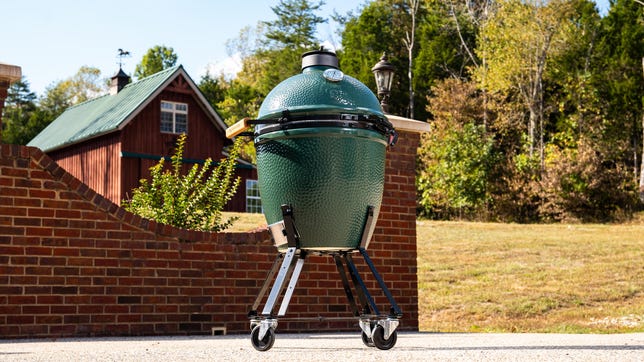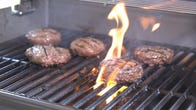Best Kamado Grill for 2022
In this article:
Those who have been in the grilling game long enough know that no other grill can compare to a kamado grill. It takes a bit of practice, but once you’re familiar with it, a kamado grill can run circles around your standard gas grill. They’re also great for wood-fired cooking, which is a technique that consistently yields delectable results.
Typically made from ceramics, these grilling champs boast amazing heat retention. A little amount of fuel goes a long way, allowing you to run a kamado cooker at slow and low temperatures all day long. Plus, you can really fire up a kamado to become scalding hot. I’m talking hot enough to cook authentic wood-fired Neapolitan pizza. A kamado grill is also great for searing true steakhouse-style steak and, honestly, just about anything you’d consider grilling.
The Big Green Egg is the most high-profile example of a traditional kamado grill and kamado smoker, but rival kamado manufacturers such as Kamado Joe, Char-Griller, Vision and Char-Broil round out this category of grills. Tempted to add one to your outdoor kitchen arsenal and become a hardcore griller? I put the Big Green Egg and its four major grilling competitors to the test to find the best kamado grill out there — here’s what I found.
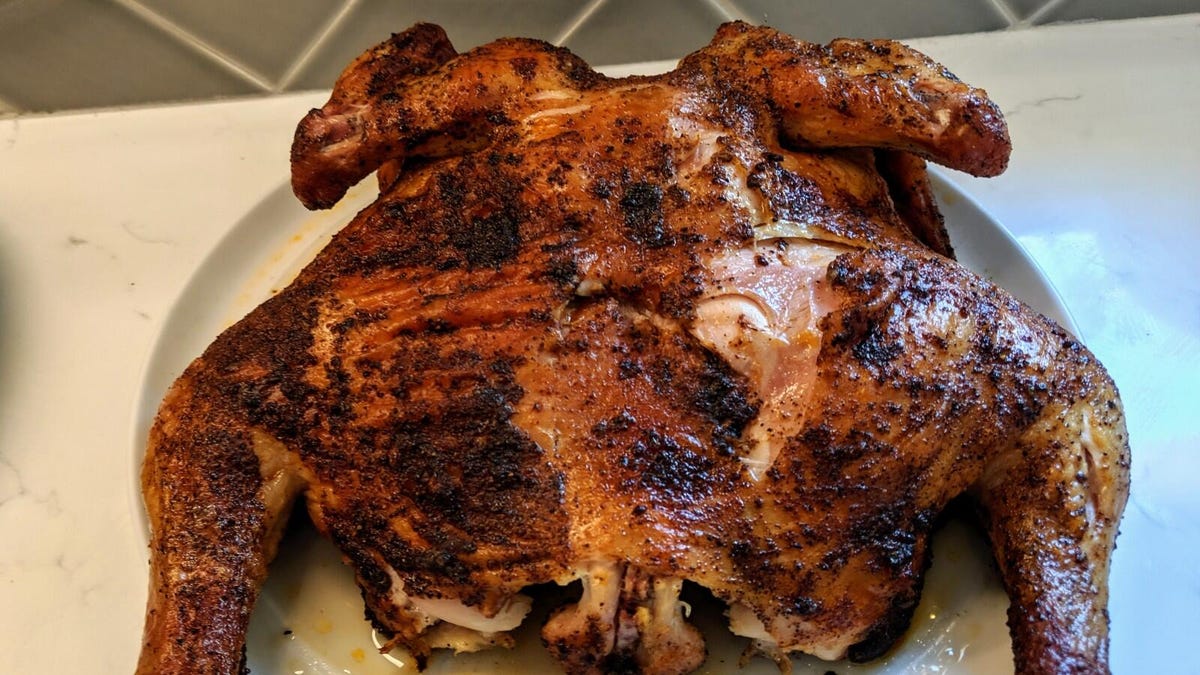
Ribs, chicken, burgers: You name it, we cooked it.
Brian Bennett/CNET
More than 200 smoke-filled hours later, I’ve cooked over 10 pounds of burgers, 20 pounds of pork ribs and six chickens, along with a few steaks for good measure. After all of that, I can say with conviction which brands make the best kamado grill for my taste and which ones you should probably avoid.
Here are my picks for the best kamado grill options for 2022. I’ll update this list as I review new products.
Best kamado grills
Chris Monroe/CNET
Big Green Egg, the company that started the kamado craze, still has a winner. Of all the kamado-style grill options in my test group, the Large BGE model had the best temperature performance, heat retention and stability. Once tuned to a low and slow temperature of 225 F, the Egg pretty much ran itself. According to our temperature gauge, the Green Egg stuck to this temperature range, with only minor and infrequent fluctuations.
The Big Green Egg also felt the most responsive. If for any reason I had to make an adjustment to either the top or bottom air vents, I saw a change quickly. I typically noticed course corrections in as little as 6 or 7 minutes.
The food I cooked in the Big Green Egg came out quite tasty as well. While my BGE test unit lacked the extra heat deflector accessory, chicken and pork ribs had convincing barbecue flavor. While not as delicious as what I smoked in the Kamado Joe Classic III, food from the BGE came in a very close second. Big Green Egg does make a heat deflector accessory, called the ConvEGGtor, but it’s an extra add-on.
True to its name, the Big Green Egg kamado grill and smoker is large, giving you lots of space so you can grill, smoke and cook to your heart’s desire.
That’s why I recommend the Large Big Green Egg as one of the best kamado grills for just about anyone. You’ll have to go through a local dealer, and, again, unlike the Kamado Joe Classic III, everything except the stand is extra. Ultimately, though, the total cost of the Big Green Egg should be less than that of a fully decked-out Classic III.
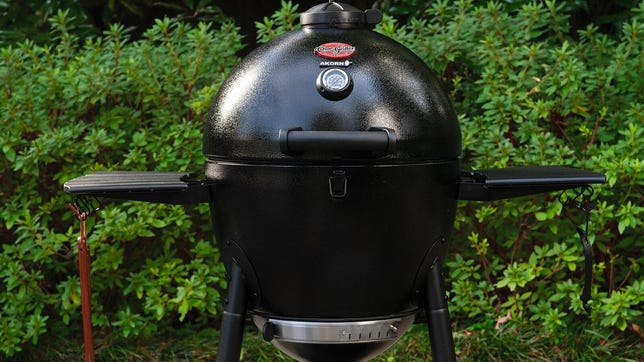
Char-Griller
The Char-Griller Akorn provides real kamado performance at a rock-bottom price. It costs less than $350, which is incredible considering typical kamado grills will set you back $800 to $1,000. The Akorn’s cooking temperature and temperature control aren’t as inherently stable as the more expensive kamados I used. I suspect that’s because the Akorn’s body is constructed from triple-walled coated steel, as opposed to a heavy ceramic cooker. The grill’s fire was also harder to ignite and keep lit than the Big Green Egg’s and Kamado Joe Classic III’s.
When I let it burn through our low-and-slow test (adjusted to 225 F), the Akorn’s fire died out within 45 minutes. After relighting, temperatures inside the cooker shot up to 370 F in a mere 15 minutes. I didn’t add extra fuel either, just one paraffin fire starter. Thirty-five minutes later, heat levels inside the Akorn hit 405 degrees. Temperatures then plateaued but remained hot, not dropping below 387 F for the next 3 hours.
Things were very different when I kept an eye on the Akorn. With a starting temperature of either 225 F or 350 F, it only took a few vent adjustments for the airflow to nudge the grill back on track. And since it’s built from steel, and is not a ceramic kamado, the Akorn weighs less (100 pounds) than traditional kamado grill options (200 pounds or more).
The food I cooked with the Akorn wasn’t bad either. Both slow-cooked baby back ribs and chicken had a pleasing charcoal flavor. That said, they couldn’t match what came out of the Kamado Joe grill thanks to its bundled heat deflector smoker system. A price this low outweighs a lot of the cons, though, so the Char-Griller Akorn adds up to a fantastic kamado style grill bargain.
You’re receiving price alerts for Char-Griller Akorn
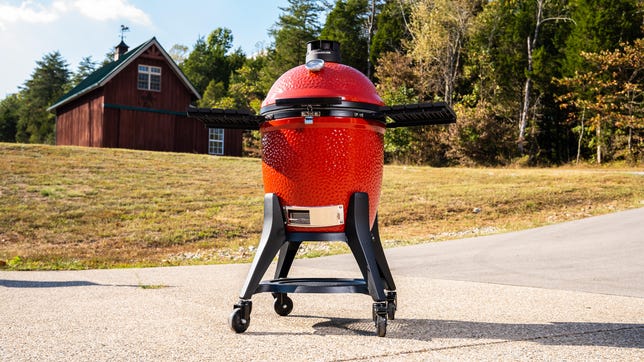
Chris Monroe/CNET
At nearly $1,500 , the Kamado Joe Classic III may have a steep price, but it delivers plenty for the money. That means lots of kamado grilling accessories that don’t come standard with other grills, including the Big Green Egg Kamado. This kamado grill and smoker performs well too. In our slow-and-low barbecue grill test, we adjust grills to 225 F (107 C) and let go of the controls to see what happens. In this trial, the Kamado Joe Classic III demonstrated excellent temperature control.
The grill got a little hot in the first 30 minutes (315 F) but then settled down at the 1-hour mark. From there, this ceramic grill coasted on cruise control, parking the needle between 253 F and 219 F for almost 3 hours. Only the Big Green Egg turned in a tighter temperature curve, humming along for hours within the smoking sweet spot.
One feature that really sets the Classic III apart is something called the SloRoller. Billed as a “hyperbolic smoke chamber” by Kamado Joe, it’s an hourglass-shaped metal contraption that sits over the fire. The apparatus functions as both a heat deflector and a convection aid. Essentially it stops radiant heat generated by the coals from striking food sitting above (on the grill grate). This prevents the meat from drying out during long cooking times. According to Kamado Joe, it also encourages air (smoke) circulation within the cooking chamber.
In fact, there are a ton of extras bundled with the Classic III right in the box. That includes an additional set of ceramic heat deflectors (one for each half of the grill), a coal stoker and an aluminum charcoal basket. You get two halved aluminum grates and an ash removal tool as well, plus a three-level cooking rack that you can configure as needed for grilling.
By contrast, everything on the Big Green Egg except the stand costs extra. Keep in mind, you can also save a little by choosing Kamado Joe’s Classic II. For $1,200 it’s almost identical to the Classic III, but lacks the SloRoller accessory and has a different stand.
The construction of the Classic III feels very solid; I especially like the sturdy side shelves, ideal for grilling and smoking, also standard. All that makes this one of the best kamado grills, if you can afford it.
You’re receiving price alerts for Kamado Joe Classic III
How we test kamado grills
Testing kamado grills is an intense experience for a griller. It requires playing with fire (literally) and high temperatures, though in a controlled, responsible way. The most critical element to kamado performance is heat, specifically temperature control and how well a grill holds to one temperature. To smoke meat low and slow, that magic number is 225 F. Good smokers, kamados or otherwise, will stick to this temp for as long as 12, 15 or 20 hours. This means the temperature gauge is key and so is the ability to control airflow via air vents or dampers.
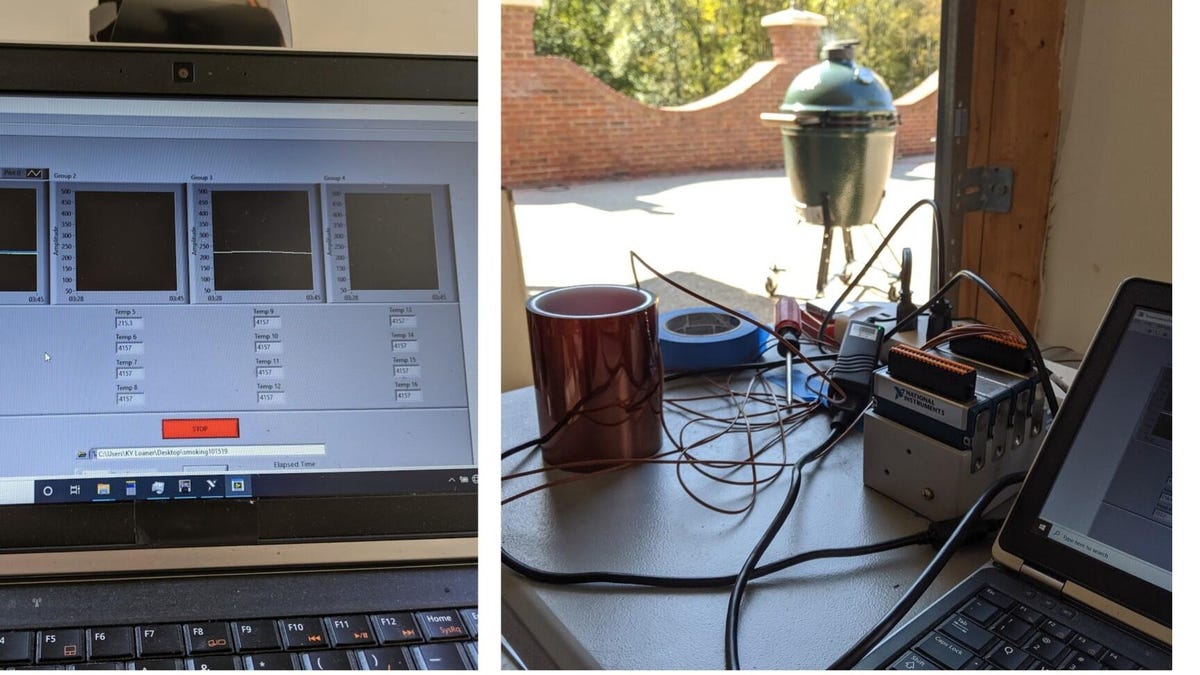
We monitor the internal temperature of the kamado grills as they go.
Brian Bennett/CNET
To capture temperature data, we put a thermocouple on each kamado grill. Essentially a sensitive temperature sensor made of a probe and a connected wire, the thermocouple hangs suspended just 1 inch above the grill grate. It’s connected to a data logger and ultimately a computer that records changes in heat levels over time.
Then it’s time to fire up each grill.
Tyler Lizenby/CNET
We try to run temperature tests on all the grills simultaneously. We also use the same weight and brand of lump charcoal (4.4 pounds or 2 kg), often from the same bag. That’s true of fire starters, too (one per grill).
A stable heat level is key to good performance for a kamado smoker.
Brian Bennett/CNET
After that, we light them up, as instructed by their manuals if available. Usually that means letting the coals catch for 15 minutes, with the lid open, then shutting the grill. At this point, vents remain wide open until the grill comes within 50 degrees of the target temp.
We carefully fiddle with the vents to get there. Lastly, we let go of the controls and observe.
We follow the same procedure for our higher-temperature test with a target of 350 F. The idea here is to simulate the heat performance required to roast chicken and other poultry.
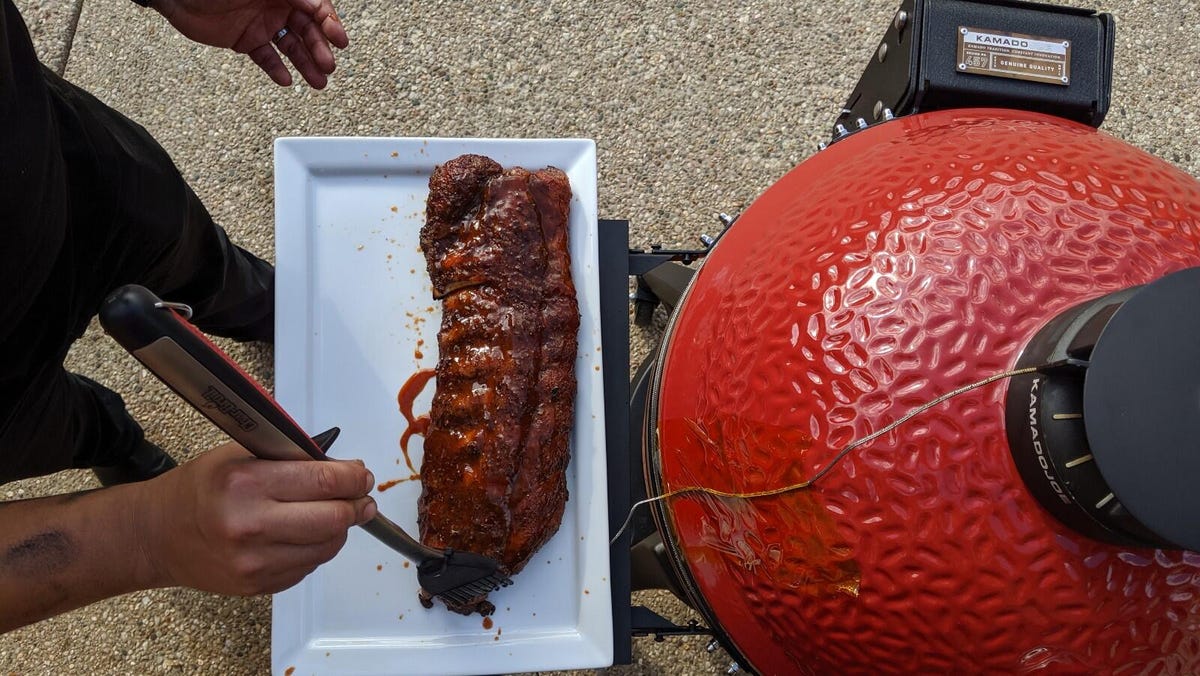
We smoke ribs along with other food for anecdotal tests.
Chris Monroe/CNET
And speaking of food, we perform lots of “anecdotal tests” too. We smoke a rack of baby back ribs (225 F) in each grill. We butterfly (aka spatchcock) chickens and roast them too. Sourced from the local Costco, these weigh roughly 5 pounds each. Last, we grill a set of four 8-ounce burger patties at high heat (600 F).
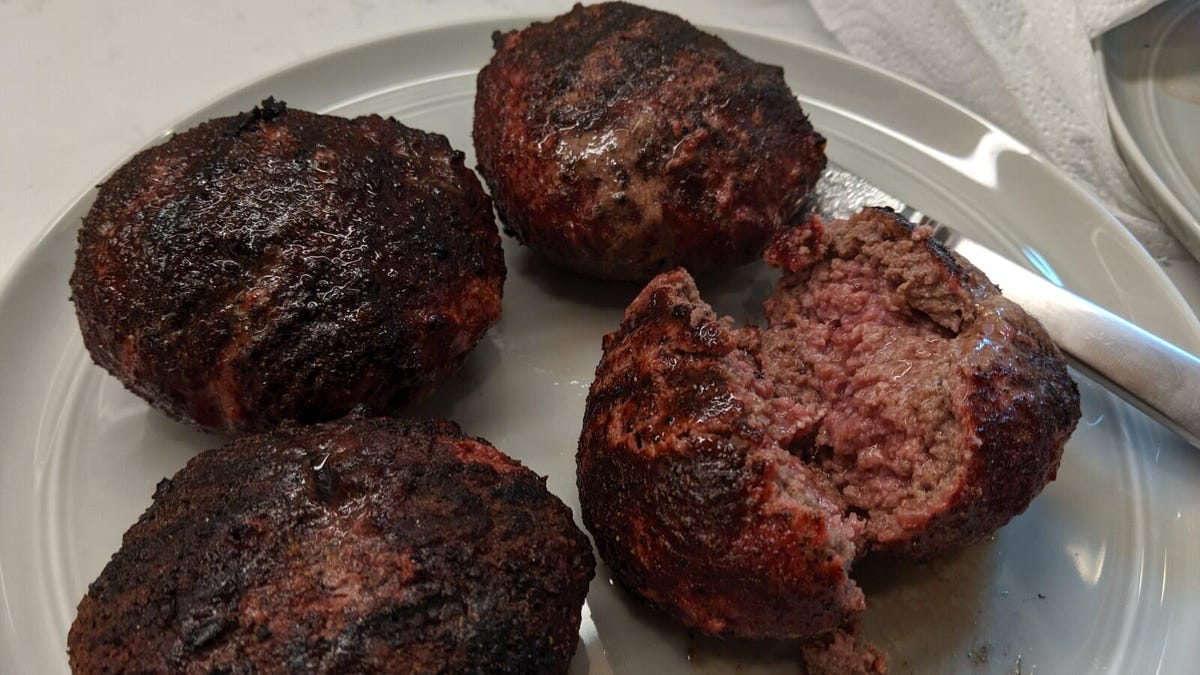
Burgers, anyone?
Brian Bennett/CNET
Want more options? Here are the other two kamado grill models I evaluated for this test group. While they didn’t make it into my picks, you may want to take a look for comparison’s sake:
More grilling recommendations
For all the latest world News Click Here


